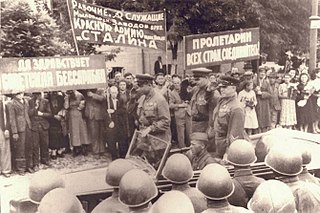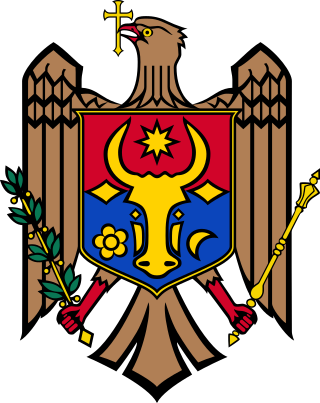The history of Moldova can be traced to the 1350s, when the Principality of Moldavia, the medieval precursor of modern Moldova and Romania, was founded. The principality was a vassal of the Ottoman Empire from 1538 until the 19th century. In 1812, following one of several Russian-Turkish wars, the eastern half of the principality, Bessarabia, was annexed by the Russian Empire. In 1918, Bessarabia briefly became independent as the Moldavian Democratic Republic and, following the decision of the Parliament, united with Romania. During the Second World War it was occupied by the Soviet Union which reclaimed it from Romania. It joined the Union as the Moldavian ASSR, until the dissolution of the USSR. In 1991 the country declared independence as the Republic of Moldova.

Moldova, officially the Republic of Moldova, is a landlocked country in Eastern Europe. It is bordered by Romania to the west and Ukraine to the north, east, and south. The unrecognised state of Transnistria lies across the Dniester river on the country's eastern border with Ukraine. Moldova's capital and largest city is Chișinău.

Bessarabia is a historical region in Eastern Europe, bounded by the Dniester river on the east and the Prut river on the west. About two thirds of Bessarabia lies within modern-day Moldova, with the Ukrainian Budjak region covering the southern coastal region and part of the Ukrainian Chernivtsi Oblast covering a small area in the north.

The Moldavian Soviet Socialist Republic or Moldavian SSR, also known as the Moldovan Soviet Socialist Republic, Moldovan SSR, or simply Moldavia or Moldova, was one of the 15 republics of the Soviet Union which existed from 1940 to 1991. The republic was formed on 2 August 1940 from parts of Bessarabia, a region annexed from Romania on 28 June of that year, and parts of the Moldavian Autonomous Soviet Socialist Republic, an autonomous Soviet republic within the Ukrainian SSR.

The State Anthem of the Moldavian SSR was the regional anthem of the Moldavian Soviet Socialist Republic, a constituent republic of the Soviet Union.

Mircea Snegur is a Moldovan politician who served as first President of Moldova from 1990–1997. Before that, he served as Chairman of the Presidium of the Supreme Soviet 1989–1990 and Chairman of the Supreme Soviet from 27 April to 3 September 1990.

The Moldavian Autonomous Soviet Socialist Republic, shortened to Moldavian ASSR, was an autonomous republic of the Ukrainian SSR between 12 October 1924 and 2 August 1940, encompassing the modern territory of Transnistria as well as much of the present-day Podilsk Raion of Ukraine. It was an artificial political creation inspired by the Bolshevik nationalities policy in the context of the loss of larger Bessarabia to Romania in April 1918. In such a manner, the Bolshevik leadership tried to radicalize pro-Soviet feelings in Bessarabia with a goal to return it in the presence of favorable conditions and creation of geopolitical "place d'armes" (bridgehead) to execute a breakthrough in the Balkan direction by projecting influence upon Romanian Bessarabia, which was eventually occupied and annexed in 1940 after the signing of the Molotov–Ribbentrop Pact.

Moldovenism is a political term used to refer to the support and promotion of the Moldovan identity and Moldovan culture primarily by the opponents of such ideas.

The Soviet invasion and occupation of Bessarabia and Northern Bukovina took place from June 28 to July 3, 1940, as a result of an ultimatum by the Soviet Union to Romania on June 26, 1940, that threatened the use of force. Bessarabia had been part of the Kingdom of Romania since the time of the Russian Civil War and Bukovina since the dissolution of Austria-Hungary, and Hertsa was a district of the Romanian Old Kingdom. Those regions, with a total area of 50,762 km2 (19,599 sq mi) and a population of 3,776,309 inhabitants, were incorporated into the Soviet Union. On October 26, 1940, six Romanian islands on the Chilia branch of the Danube, with an area of 23.75 km2 (9.17 sq mi), were also occupied by the Soviet Army.

The coat of arms of the Moldavian Soviet Socialist Republic was adopted on 10 February 1941 by the government of the Moldavian Soviet Socialist Republic. The coat of arms is based on the coat of arms of the Soviet Union. It shows symbols of agriculture, an outer rim featuring wheat, corn, grapes and clover. The red banner bears the Soviet Union state motto in both the Romanian language and the Russian language. In Romanian, it was initially "Пролетарь дин тоате цэриле, униць-вэ!"; then, from the 1950s "Пролетарь дин тоате цэриле, уници-вэ!". Both are written in the Latin alphabet as "Proletari din toate țările, uniți-vă!". The acronym MSSR is shown only in Romanian in Moldovan Cyrillic ("РССМ"). The emblem was replaced on 3 November 1990 by the present coat of arms of Moldova. Currently, the unrecognized breakaway state of Transnistria uses a similar state emblem.

The Popular Front of Moldova was a political movement in the Moldavian SSR, one of the 15 union republics of the former Soviet Union, and in the newly independent Republic of Moldova. Formally, the Front existed from 1989 to 1992. It was the successor to the Democratic Movement of Moldova, and was succeeded by the Christian Democratic Popular Front and ultimately by the Christian-Democratic People's Party.

The Pridnestrovian Moldavian Soviet Socialist Republic (PMSSR), also commonly known as Soviet Transnistria or simply as Transnistria, was created on the eastern periphery of the Moldavian Soviet Socialist Republic (MSSR) in 1990 by pro-Soviet separatists who hoped to remain within the Soviet Union when it became clear that the MSSR would achieve independence from the USSR and possibly unite with Romania. The PMSSR was never recognised as a Soviet republic by the authorities in either Moscow or Chișinău. In 1991, the Pridnestrovian Moldavian Republic succeeded the Pridnestrovian Moldavian Soviet Socialist Republic.

The Declaration "On the Restoration of Independence of the Republic of Latvia" was adopted on 4 May 1990 by the Supreme Soviet of the Latvian SSR in which Latvia declared independence from the Soviet Union. The Declaration stated that, although Latvia had de facto lost its independence in 1940, when it was annexed by the Soviet Union, the country had de jure remained a sovereign country as the annexation had been unconstitutional and against the will of the Latvian people. It asserted the priority of the basics of the international law over the national laws and therefore it resolved that the Molotov–Ribbentrop Pact and the Soviet occupation of Latvia in 1940 were illegal. It also asserted that the heavily rigged 1940 elections were illegal and unconstitutional, and that all acts of the People's Saeima chosen at that election–including the request to join the Soviet Union on 21 July 1940–were ipso facto void.

Alexandru Diordiță was a Moldavian politician, who served as Chairman of the Council of Ministers of the Moldavian Soviet Socialist Republic (1958–1970).

Ivan Ivanovich Bodiul was a Soviet and Moldovan politician prominent in the Moldavian SSR, particularly during the Brezhnev era.

Nikita Leontyevich Salogor was a Moldavian and Soviet politician who served as First Secretary of the Communist Party of Moldavia (PCM) in 1942–1946. Of Romanian Ukrainian or Moldovan roots, he had a kulak mother, whom he openly denounced later in life. Salogor's early career was in agricultural institutions of the Ukrainian SSR and the Moldavian Autonomous Soviet Socialist Republic, where he also advanced politically. Following the Soviet advance into Bessarabia in 1940, he joined the leadership of the Moldavian SSR. Immediately promoted to Junior Secretary of the PCM, he was co-opted on its Politburo in early 1941, and took part in a workforce recruitment drive, which is described by historian Ion Varta as connected to the deportation of native Romanians.

The Constitution of the Moldavian Soviet Socialist Republic (1941) was the fundamental law of the Moldovan SSR, adopted in 1941.

Fyodor Grigoryevich Brovko was a Soviet and Moldavian politician who served as the Chairman of the Presidium of the Supreme Soviet of the Moldavian Soviet Socialist Republic from 1941 to 1951.

Greater Moldova or Greater Moldavia is an irredentist concept today used for the credence that the Republic of Moldova should be expanded with lands that used to belong to the Principality of Moldavia or were once inside its political orbit. Historically, it also meant the unification of the lands of the former principality under either Romania or the Soviet Union. Territories cited in such proposals always include Western Moldavia and the whole of Bessarabia, as well as Bukovina and the Hertsa region; some versions also feature parts of Transylvania, while still others include areas of Podolia, or Pokuttia in its entirety. In its most post-Soviet iterations, "Greater Moldova" is associated with a belief that Moldovans are a distinct people from Romanians, and that they inhabit parts of Romania and Ukraine. It is a marginal position within the Moldovan identity disputes, corresponding to radical forms of an ideology polemically known as "Moldovenism".
The Day of the Union of Bessarabia with Romania is a public holiday of Romania celebrated every 27 March to commemorate the union of Bessarabia with Romania on 27 March 1918. Bessarabia is a Romanian historical region that was part of the Principality of Moldavia, which united with Wallachia to form modern Romania. The region was annexed in 1812 by the Russian Empire, but it became independent and united with Romania on 27 March 1918.

















